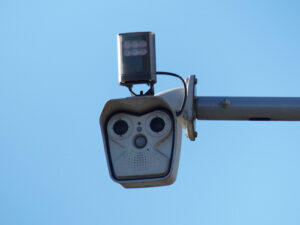 Intelligent Transport Systems (ITS) are a combination of advanced information and communication technologies used in transportation and traffic management systems to enhance the efficiency, safety and sustainability of transportation networks. Here Raytec provides some practical tips.
Intelligent Transport Systems (ITS) are a combination of advanced information and communication technologies used in transportation and traffic management systems to enhance the efficiency, safety and sustainability of transportation networks. Here Raytec provides some practical tips.
When designing a lighting solution for Intelligent Transport Systems there are various factors which need to be taken into consideration. Filtering these factors into the overall design helps to deliver the correct optical and lighting set up to capture a number plate effectively. In this article, we give you some practical tips to help you achieve the perfect solution.
Distance and Angle
You need to consider the distance to the target, the horizontal field of view, and the camera mounting position. These will all contribute to the quality of the image captured.
In addition, when designing your lighting scheme, you also need to consider:
- Wavelength: What is required? White-Light, Infra-Red, or other? Most basic ANPR (Automatic Number Plate Recognition) applications utilise 850nm Infra-Red illumination, which we’ll look at closely in the next section, but some plates from around the world may require different wavelengths, particularly White-Light for coloured plates.
- Field of view: The field of view of the lighting should be matched with the field of view of the camera & lens.
- Power & quality: High power, high quality illumination is essential for transport applications when fast shutter speeds and higher f-stops require more light.
- Adjustable angle: Products that can have their angle easily adjusted on-site makes installation much easier.
- Field proven: Manufacturers with experience in lighting for transportation applications are critical to ensure reliability.
- Certification: Ensure selected products carry the relevant certifications and approvals.
- Testing: Continuous testing is critical to ensuring the best results from your ITS.
- Retroreflective plates: Mount the lighting as close to the camera as possible for maximum capture of light. Also make sure to mount the camera/light combination at an incidence angle of less than 35 degrees. An incidence angle of greater than 35 degrees would destroy the benefits of the retroreflective plate.
Infra-Red Lighting
An ITS will normally operate 24 hours, 365 days a year. To provide high quality image capture the system must be able to cope with a wide range of lighting conditions. A standard surveillance camera simply cannot cope with these changing conditions. To overcome this difficulty, the system must provide a reliable and consistent level of illumination regardless of any other lighting factor.
Infra-Red lighting is generally the most commonly used for ANPR applications, particularly if there is little colour information required from the capture of the plate. Some systems will require White-Light to obtain additional information from the plate but then care must be taken to avoid blinding the occupants of the vehicle, particularly the driver.
For Infra-Red systems, to allow the camera to blank out any ambient light sources it is fitted with a narrow band pass filter which is normally attached to the camera lens. Only light of a certain wavelength can pass through. The spectral response of the band pass filter must match the spectral output of the Infra-Red source used. It is normal for a number plate capture system to use an 850nm light source. This should be mounted adjacent (as closely as possible) to the camera, to take full advantage of the retroreflective properties of the plate.
Challenging Environmental Conditions
Last but not least, ITS applications are typically deployed in very challenging environments. You need to ensure that the lighting has proper certification for the specific application, and you need to ensure that the lighting is designed for extreme environments and operating conditions. Variable weather conditions, variable temperatures and high vibration can all impact the quality of the image obtained. Without a high-quality image, you will be unable to clearly analyse the data for ANPR/ LPR purposes.


